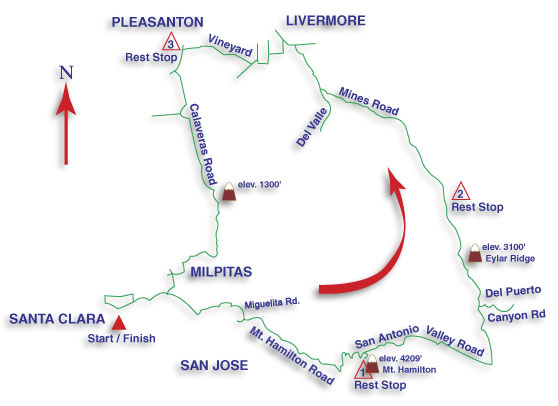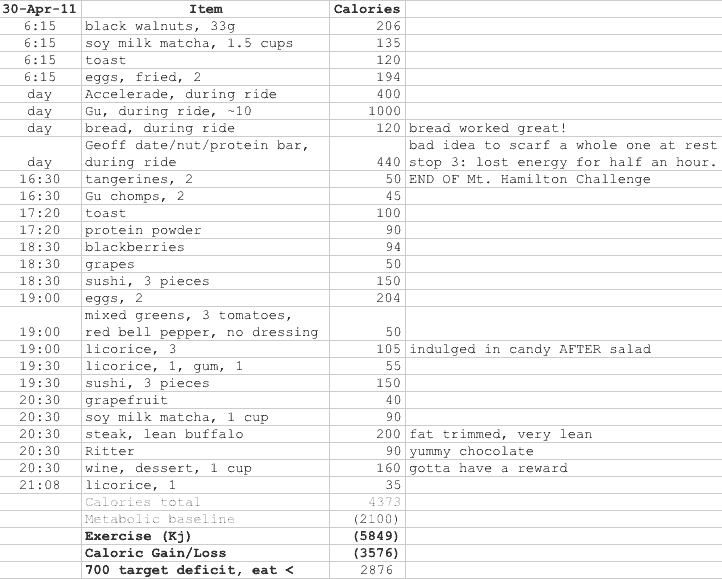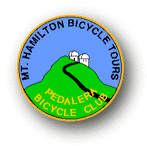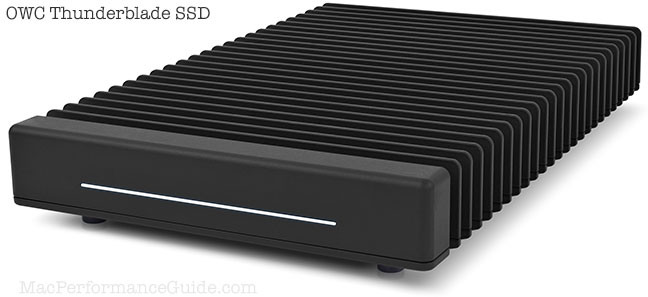Mt Hamilton Challenge — 125 Mile Loop Ride, Santa Clara, CA
Related: double century, Everest Challenge, exercise, hard core, Rides, training, ultra endurance exercise
The Mt Hamilton Challenge is a 125 mile loop with 8300 feet of climbing starting in Santa Clara, CA. I did it for the first time in April 2011.
Food and water
You bag your own food, which is delivered to each of the three rest stops.
I brought both food and water (with Accelerade), so I just had to throw away my existing empty water bottles, grab my food bag and the next set of 1-liter Evian throw-away bottles, get on my bike, and go.
I do not like to stop more than 1-2 minutes— bad idea for an endurance event, and I find that my muscles start to shut down and stiffen, if it’s cold the body core temperature starts to drop, etc, so I grab and go.
The good miles
The mileage on Mt Hamilton Road to the summit is as good as you’ll find— gorgeous views, good pavement, very little traffic, a joy to ride.
The top of Mt Hamilton can be quite cold; April 30 2011 warmed up by 5-10°, but the day earlier the wind-chill had been 32.6° F (freezing).
The good miles continue down the other side of Mt Hamilton along Mines Road (into a very stiff headwind in 2011), until the Livermore area.
Mines Road is relatively level along much of its length up to Rest Stop 2 or so, then beings to offers sweeping downhills that are great fun, with a steep downgrade into Livermore, really fun until a 30 mph side-gust hits and that gets a little scary.
The Calaveras road section is an outstanding section with a generously wide road nearly free of cars, offering a steady gentle grade, and with a bird’s eye tree-lined view of the reservoir.
The junk miles
There are about 17 “junk miles” from the start in Santa Clara to Mt Hamilton Road, as well as more junk miles once existing from the Calaveras Road descent and also some not so great miles in the city of Livermore areas.
These miles really do suck: too much traffic, and one must be constantly on the lookout for broken glass, small chunks of lead, and general debris.
These miles are not just junk miles, but risky miles, especially with tubulars, where a flat tire means a serious hassle, and a $160 tire+glue job replacement (and a spare that requires care for cornering). Add in the tiny route markers, no turn confirmation markers, the traffic, and it’s a really crappy riding experience for those miles— about 30 miles of such yuck.

Maps and markers
You are provided with a route map in tiny type (if you’re 45+, presbyopia makes such thing highly irritating— difficult to read). The detailed route map is not provided in advance (or at least I could not find a PDF) so I was not able to study it in advance or print it on decent paper.
The route is marked with small painted-on markers on the pavement which are easy to miss; you have to constantly monitor the pavement if you think a turn is approaching. Staring at pavement while worrying about traffic is not my idea of fun.
WORSE, you can go for miles with NO confirmation markers, and there are NO turn-confirmation markers either. Much room for improvement in my vie.
I spoke with a number of other riders, some of whom had done it before— and even together we missed some turns. Even the 3rd rest stop was not obvious, and there was NO MARKER. You had to just know that the green balloons meant something, and know in advance the name of the park (study that route map in 6 point type).
When I’m tired I want to ride, not stare at a map with tiny type, or fixate on the pavement.
Making it better
I don’t know why the race organizers insist on all those junk miles. I probably will NOT do it again, just because of the nuisance factor.
The race could be hosted in a park very near the Mt Hamilton Road (or even Grant Ranch County Park), and be done as an out-and-back, for a far more pleasant experience, with lower traffic and flat risk, less rider where-is-that-turn stress, and more of a challenge (up and down both sides, out to Mines Road and back, etc).
As a training ride for the Everest Challenge
The Mt Hamilton total ascent is half that of the first day of the Everest Challenge barely gets above the EC minimum altitude, but the mileage is nearly identical (to the first day of EC), so it’s a good early season trial run to check out not just fitness, but body and bike over a longer distance.
Riding Notes
I treated the Mt Hamilton Challenge as an early season training ride for the Everest Challenge stage race. As such, I rode it as hard as I could, to get a handle on my early season fitness, to flush out any bugs in comfort or equipment.
Average watts: 196 watts @ 130 bpm
Hamilton climb: 260 watts @ 145 bpm (main portion after Grant Ranch)
I had no trouble passing every rider on Mt Hamilton ascent, and no one passed me, yet I was running only 83% of my max heart rate. The lower body weight was a major contributing factor, which I could feel in the ease of getting up the grade.
How I did
I gauged my efforts on my own historical perspective and I was very pleased. But as an objective confirmation (and to brag a little), not one person passed me the entire day, and I lost count of how many people I passed— most of them I think (people start on their own schedule, I started a little late). At one point, I was pulling a group of a dozen riders, but I dropped them in Livermore and left them miles behind. I was feeling my oats, so to speak.
I finished strong, pulling a group of riders for which I slackened my pace, still able to maintain 250 watts for good stretches after nearly 8 hours of riding. The ability to sustain that kind of power at the very end means that fueling and hydration had been excellent overall. And it’s essential for the Everest Challenge.
Because of navigational errors and thus backtracking, I ended up riding 132.13 miles, 7 miles more than specified.
What I ate and drank
It was a cool day— I drank only four one-liter bottles of water containing 1 scoop of Accelerade each (100 calories each). The rest of my calories came from Gu energy gel and at rest stop #2, one piece of toasted sourdough bread, which seemed to work better than just about anything else! I used about 10 energy gels total, returning with a pocket stuffed full of unused ones.
Starting at about 2:00, I consumed one Gu energy gel every 40 minutes or so. I also ate a friend’s home-made energy bar, which worked fine eating about 1/4 of one 220 Cal bar every 20 minutes, but gut-bombed me eating a whole one at rest stop #3, which took me 30-40 minutes to recover from. Those bars had way too much fructose content, and nuts, tasty, but no good for quick energy. I recovered by taking a Gu and fluid. This was a good lesson for future events— energy bars are a bad choice except when eaten in small chunks.
Recovery
One Gu energy gel, two tangerines, 3 X 1000mg vitamin C, one multi-vitamin right after finishing. The rest of the day’s eating is shown below.
Then I consumed about 120g of bread every half hour for a few hours, along with some protein powder and some veggies and some candy, and later, a lean buffalo steak with wine.
I gauge recovery effectiveness by the next day’s power,, where I had a strong ride, with little of note except sore gluteus muscles— nearly normal power (watts), quite remarkable less than 24 hours after the 132 event.

What I rode
I rode the Mt Hamilton Challenge on my lithe Trek Madone 6.9 SSL, and the Lightweight Obermayer wheels. The aero form factor helped a lot into the wind, but was a little scary at 3-+ on some descents when side-gusts blasted me.
I decided not to ride with my usual daytime running light, because although the < 1/2 pound or so is really not not a big deal, it’s still 8300 feet of ascent.
Tapering for the event
After four solid months of riding, my legs were in a chronic state of being almost-recovered. So I tapered with rides of 3/4, 1/2, 1/3 length in the three days prior to the event. This paid off with a performance greatly exceeding my expectations.




